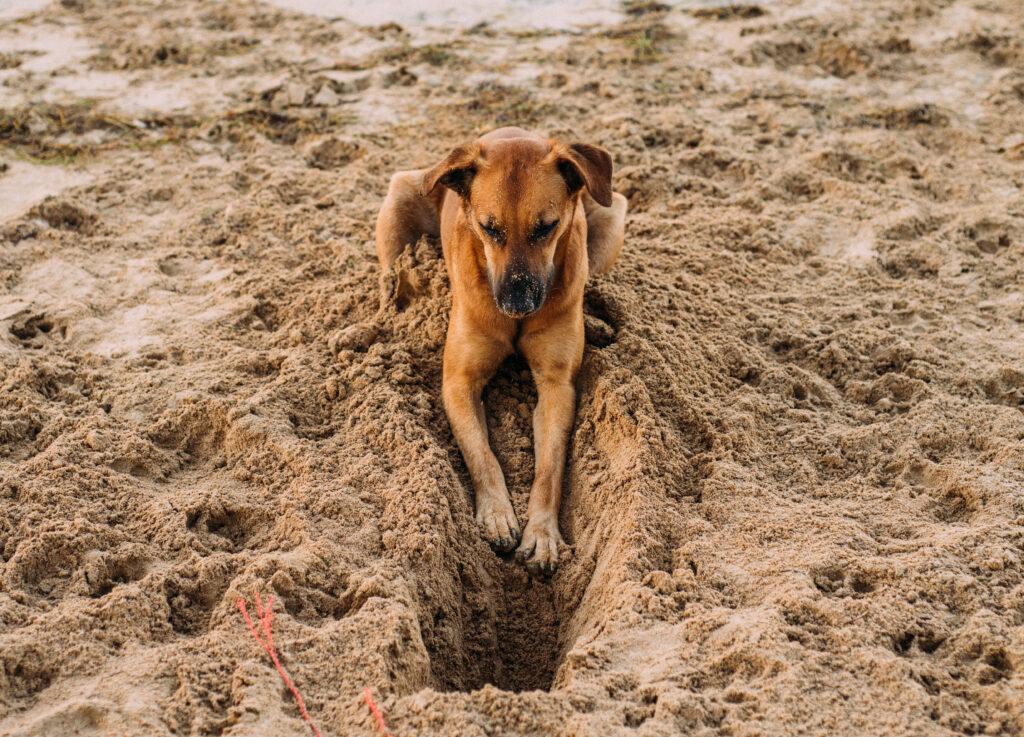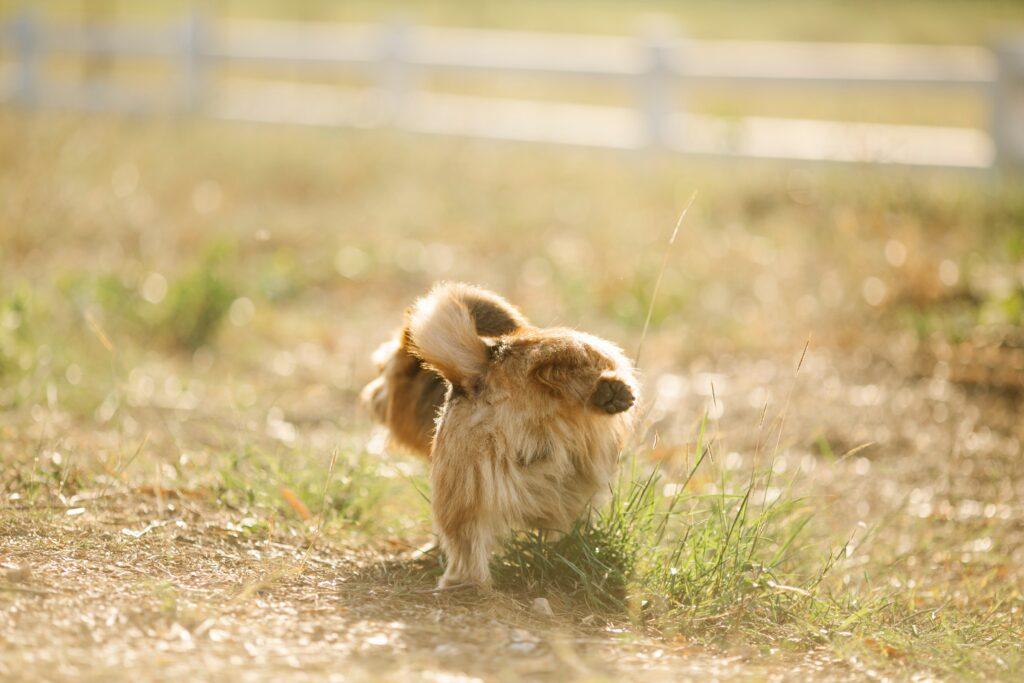Give your dog a designated digging area and restrict him unsupervised access to the areas where you don’t want holes to be dug if you want to completely stop undesired digging.
Digging is among many dogs’ favorite pastimes when it comes to their natural behavior. Digging is frequently discouraged for dogs who live with people, which is unfortunate.
There are many reasons why dogs dig holes in the ground:

Avoiding digging entirely is the best solution. Until you’re sure your doggy can amuse himself without digging, don’t leave him outside unattended. Look around your yard to find the best sites for digging, such as gopher mounds, regions with loose ground, or damp areas that are conducive to digging. Of course, some dogs may dig wherever they feel like it, but removing the temptation makes it simpler to focus your dog’s attention on better habits.
If you must leave your digging doggy alone in the yard, use management to help stop practice sessions for the undesirable activity. If your dog likes to dig, you might want to consider a secure enclosure like a dog run or utilize a reliable exercise pen that is set up to prevent access to certain places. Just while she is learning, though; it won’t last forever!
It’s a good idea to assess your dog’s overall enrichment honestly. Does your dog go for daily walks outside of the house and/or yard? Is the path always the same? Do you vary your routine by doing some exercise while you walk? Does your dog ever accompany you on errands to new (dog-friendly) locations if he is comfortable in public? Dogs frequently dig when they’re bored. Ask him honestly what else he has planned for the week to see if you can shake things up a bit.
If your dog has a history of digging up stuff, try some of the following:
Create a digging pit by filling a plastic wading pool or a child’s sandbox with sand or dirt. Compared to dirt, sand leaves less of a mess. bury the toys your dog enjoys most. Show him the reward pit and assist him in finding it with excitement. Don’t forget to replace the toys buried within the pit and continue assisting him in finding the treasures. The “hides” may get smaller and more difficult to spot as he improves.
Digging holes at random? Try replacing the majority of the dirt in the hole, adding some of your dog’s waste on top, then covering it with the remaining earth. Digging for fun and discovering waste can be very unpleasant for some dogs. As your dog tries out new digging techniques, you’ll probably need to repeat this process a few times, but for many dogs, the regular experience of uncovering waste will cause them to reevaluate their backyard behavior, especially when combined with your efforts to give them more enjoyable activities.
You find it difficult to poop in your dog’s favorite holes. Use the same method, except instead of excrement, use a piece of chicken wire that has been cut to fit the hole’s surface area.
We advise creating a trough along the fence for fence diggers, then filling it with massive, upright stone pavers. Another option is to bury an 18-inch-tall chicken wire trip about a foot beneath the bottom of a wooden fence.
Most crucial, keep in mind that behavior doesn’t alter suddenly. It may take up to a few months of consistency before you notice a noticeable difference in your dog’s digging, so you’ll need to be consistent in your efforts to lessen it using a combination of teaching and management. Avoid digging yourself a deeper hole by giving up too soon!
If you are interested in purchasing a Dog Knee Brace from us please check out our store and if you are interested in join our Facebook Page click here.
One of the first things you’ll do to help your dog adjust to his new home is potty training, and there are several different approaches you can take. To ensure success for both you and your dog, try these seven tips.

Decide where you want your new friend to “go” outside the house before you start potty training. Do you have a yard? Point them in the direction of a place that is easy to reach from the door. Dogs living in apartments should also be able to recognize open, accessible natural terrain that isn’t blocked by people or vehicles.
Once you’ve chosen the location you’ll take your dog during this potty training phase, be sure to take them there each time they need to go outdoors. Consistency is key while teaching a puppy to use the bathroom since dogs can scent their territory.
Although your new puppy may not be able to communicate with you in your native tongue, they will nonetheless make an effort to let you know when they need to go potty. Fortunately, there are several indicators you can watch for. As soon as you see them, take your dog outdoors to their designated potty training area:
When your dog exhibits the final symptom on the list, it might already be too late. So that they are aware that their customary space is up for grabs before they go in the wrong location, be prepared to open the door nonetheless.
Plan beforehand so you can swiftly take your dog outside if you see any of these symptoms. Keep a leash directly by the door so you can quickly lead the pet outside. Keep in mind to direct your dog to the same location each time they need to urinate. Once they are aware of the location of their designated bathroom, they will go there on their own.
Maintain a routine for all meal and snack times while potty training a dog. This is beneficial in two ways: The first benefit of planned meals is that they will teach your dog when to expect meals throughout the day. Second, if you feed your dog at regular intervals, you may follow up and take them to their designated potty training area in the knowledge that they’ll be prepared to relieve themselves shortly after they finish eating.
It’s likely that your dog will urinate frequently if they consume a lot of water. During the potty training stage, take your puppy outside soon after drinking so that they are in the appropriate location at the appropriate time.
Take your dog outside as soon as you wake up, after each feeding, and whenever you notice signs that they might need to relieve themselves. A lot of dogs have a bowel movement 30 minutes after eating. Until you have a better understanding of how frequently your dog does potty, take them outside every hour to prevent accidents. Based on their age, the following are some rough guidelines for how long puppies can “hold it”:
While small breeds with smaller bladders may require more frequent bathroom breaks, big breeds have a stronger ability to wait. Most dogs can wait seven hours or more by the time they are seven months old. They ought to know how to alert you when they need to go outside by that age. Always take your dog out before you go to bed to prevent 3 a.m. wake-up calls or morning surprises.
Everyone enjoys being told when they are doing a good job, and your dog will benefit greatly from this encouragement. It doesn’t matter if you give them treats or just pat them while saying “excellent work.” Just make sure they understand how much you value their attempts to conduct themselves properly. To teach the command “go to the bathroom,” think about identifying the deed. For instance, you might tell your dog to “take a break” before engaging in play.
Puppies prefer not to go potty close to where they eat or sleep. By crate training your dog, you can use it to reinforce housetraining. A puppy can easily relieve themselves in one part of a bathroom or laundry room while sleeping and playing in the remaining areas. If you need to use the phone or check your email while keeping an eye on your young dog, keep them in their kennel.
They will let you know if they need to use the restroom because they won’t want to mess up this place. Put them back in the kennel when you reach home if they play unproductively while outside. A crucial lesson that every puppy should learn is that if they mess up the kennel, they will have to temporarily live with it.
Accidents happen frequently during house training. When your dog needs to go outdoors to the designated pee place, quietly direct them there immediately away. Punishing a puppy could exacerbate the problem and lead to more accidents at home.
Clear the space right away. Ammonia should be avoided since it smells a lot like pee. While disinfecting, bleach cannot get rid of odors. Your dog will probably go potty there again if they smell feces in your house. Use an enzymatic cleanser or odor neutralizer made especially for pet excrement to clean the stained area. While it dries, keep your dog away from the area.
When encountering new people or animals, puppies may squat out of excitement or respect. Before meet-and-greets, give them bathroom breaks to prevent a mess. Take frequent bathroom breaks while traveling as well. If you want to board your dog while you are away, make sure to provide the facility detailed instructions to ensure consistency. Restart house training if you move to a new residence. Limit them to one area of the house, show them where the new toilet is, and give them praise when they behave well.
Many dogs don’t like going outside in the rain or don’t like going potty in the snow. A puppy may be terrified of the cold and rain for the first time, but even older dogs prefer to potty in comfort. To provide some weather protection, keep an umbrella close at hand.
Create a trail to your dog’s chosen bathroom location so they can go without exposing their tails to the bitterly cold ground. Increase their reward for using the restroom in poor weather by giving them twice as many treats. This will lessen the likelihood of unpleasant surprises beneath the piano bench. Even the best-trained dogs are more likely to have accidents in the house if they are overly anxious, stressed out, or afraid. Consult your veterinarian to rule out any health issues whenever your house-trained dog has a number of accidents.
Not all dogs pick things up at the same rate. By eight or ten weeks old, some puppies are experts at house training. Other puppies, such those of toy breeds, may take longer to grasp your expectations and may not show consistency until they are a few months old. In most circumstances, all dogs can learn to relieve themselves in a permitted area with your patience, encouragement, and persistence.
If you are interested in our Posh Dog Knee Brace you can purchase one through our Store or if you have any questions you can reach us on our contact page. If you would like to learn more about us you can also check out our Facebook Page and community.